August 21, 2013
The beginning of the school year for teachers is filled with the overwhelming task of not only organizing the classroom, but also deciding on how to create a sense of community in those first few weeks. Topics such as adjusting to a new school environment, creating friendships, tolerance, self-understanding, the importance of creativity and readership, and teen issues are destined to come up in classrooms throughout the course of the year. These back to school books not only introduce the previously mentioned topics, but may also aid teachers and students in becoming like Cowgirl Nellie Sue in Rebecca Janni’s picturebook Every Cowgirl Goes to School, with the mindset that “It is a brand-new day, and I decided it would go just my way” (unpaged). We hope that the books in this week’s reviews, written by members of the Children’s Literature and Reading Special Interest Group, serve as a guide in helping teachers, no matter what their classroom setting, in preparing their students for the most successful back to school year yet!
GRADES K-3
Fergus, M., & Lowery, M. (2013). The day my mom came to kindergarten. Toronto: Kids Can Press.
 In this humorous and engaging book, Fergus and Lowery provide an opportunity for a little girl to observe her mother’s behavior when the mother is invited to spend the day in her daughter’s kindergarten classroom. The little girl tries to explain basic kindergarten behavior to her mother. However, the mother forgets all her advice and often embarrasses other children in the class. She runs, yells, jumps, and interrupts others inappropriately. Yet, the teacher is open-minded and supportive. She instructs the children to remember their experiences being newcomers and to be kind to the protagonist’s mother. The cartoon style illustrations are simple and fun and will definitely inspire children to talk about their school day as well as draw or paint pictures of their first day at school. The Day My Mom Came to Kindergarten is a good read-aloud book for both a classroom activity and leisure time.
In this humorous and engaging book, Fergus and Lowery provide an opportunity for a little girl to observe her mother’s behavior when the mother is invited to spend the day in her daughter’s kindergarten classroom. The little girl tries to explain basic kindergarten behavior to her mother. However, the mother forgets all her advice and often embarrasses other children in the class. She runs, yells, jumps, and interrupts others inappropriately. Yet, the teacher is open-minded and supportive. She instructs the children to remember their experiences being newcomers and to be kind to the protagonist’s mother. The cartoon style illustrations are simple and fun and will definitely inspire children to talk about their school day as well as draw or paint pictures of their first day at school. The Day My Mom Came to Kindergarten is a good read-aloud book for both a classroom activity and leisure time.
- Oksana Lushchevska, The University of Georgia
Janni, R. (2013). Every cowgirl goes to school. New York: Dial Books for Young Readers.
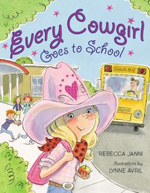 Nellie arrives at school on the first day all dressed up in her cowgirl hat, cowgirl boots, and bandana. She also has her "All About Me" bag that includes five things to share with her new classmates. On the first day of school she has the typical first day worries. She finds that her best friend may have a new best friend, and she even has to take off her cowgirl boots in gym class where she gets hit in the shin with a kickball. Nellie’s day continues to get worse after lunch when she finds someone has put a picture on her desk that seems to be making fun of her. Nellie learns that it’s all a matter of perspective and ends up finding a new friend and an additional item to add to her All About Me Bag. This would be a perfect story for younger grade teachers to read as a preview to their All About Me Bag activity at the beginning of the school year.
Nellie arrives at school on the first day all dressed up in her cowgirl hat, cowgirl boots, and bandana. She also has her "All About Me" bag that includes five things to share with her new classmates. On the first day of school she has the typical first day worries. She finds that her best friend may have a new best friend, and she even has to take off her cowgirl boots in gym class where she gets hit in the shin with a kickball. Nellie’s day continues to get worse after lunch when she finds someone has put a picture on her desk that seems to be making fun of her. Nellie learns that it’s all a matter of perspective and ends up finding a new friend and an additional item to add to her All About Me Bag. This would be a perfect story for younger grade teachers to read as a preview to their All About Me Bag activity at the beginning of the school year.
- Chelsey Bahlmann, The University of Georgia
Morstad, J. (2013). How to. Vancouver: Simply Read Books.
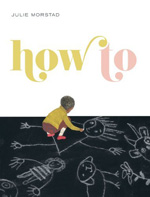 How To vividly portrays the unlimited possibilities of imagination. Morstad represents a playful game through her illustrative narrative and adds poetic vibrancy with her words. Her gorgeous illustrations show how to do things in a number of ways such as going fast or slow, feeling a breeze, hiding, sleeping, making friends, and many other essential activities. All these small things fill up an ordinary day and make people happy. Starting with the book jacket, the author sets a joyful mood, which makes the reader wish to join the main characters. Morstad uses lines to not only animate her characters but also to provide an energetic and bright flow to her story. Thus, readers will be easily transported by the depicted scenes, and the book will become a must-have title for a classroom library.
How To vividly portrays the unlimited possibilities of imagination. Morstad represents a playful game through her illustrative narrative and adds poetic vibrancy with her words. Her gorgeous illustrations show how to do things in a number of ways such as going fast or slow, feeling a breeze, hiding, sleeping, making friends, and many other essential activities. All these small things fill up an ordinary day and make people happy. Starting with the book jacket, the author sets a joyful mood, which makes the reader wish to join the main characters. Morstad uses lines to not only animate her characters but also to provide an energetic and bright flow to her story. Thus, readers will be easily transported by the depicted scenes, and the book will become a must-have title for a classroom library.
- Oksana Lushchevska, The University of Georgia
Overdeck, L. (2013). Bedtime Math: A fun excuse to stay up late. Illus. by Jim Paillot. New York, NY: Feiwel &Friends.
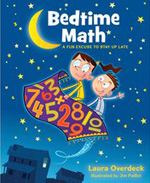 Bedtime Math is a book written by Laura Overdeck, the founder of the phenomenally successful math education website recommended by many parents, teachers, and school principals. Like she said in the introduction—“Math should be loved by kids as much as bedtime stories”—she designed this book in a fun way. The book is divided into four chapters, each with a mischief-making topic: exploding food, wide pets, extreme vehicles, and sports you shouldn’t try at home. While doing math problems, children get to enjoy the fun facts about food, pets, and sports in their everyday world, such as the points of hotness for black pepper and the good side of being a meteorologist. Each math story has math problems of three levels of challenges: Wee Ones, Little Kids, and Big Kids, so children can find something that is suitable for them to tackle and see themselves progress along the difficulty levels. Jim Paillot’s lively and energetic illustrations make children want to invest in these math problems. Learn more about Bedtime Math at the author’s website.
Bedtime Math is a book written by Laura Overdeck, the founder of the phenomenally successful math education website recommended by many parents, teachers, and school principals. Like she said in the introduction—“Math should be loved by kids as much as bedtime stories”—she designed this book in a fun way. The book is divided into four chapters, each with a mischief-making topic: exploding food, wide pets, extreme vehicles, and sports you shouldn’t try at home. While doing math problems, children get to enjoy the fun facts about food, pets, and sports in their everyday world, such as the points of hotness for black pepper and the good side of being a meteorologist. Each math story has math problems of three levels of challenges: Wee Ones, Little Kids, and Big Kids, so children can find something that is suitable for them to tackle and see themselves progress along the difficulty levels. Jim Paillot’s lively and energetic illustrations make children want to invest in these math problems. Learn more about Bedtime Math at the author’s website.
- Xiaoli Hong, The University of Georgia
Plourde L. (2013). You are wearing THAT to school!? Illus. by Sue Cornelison.New York, NY: Hyperion Books.
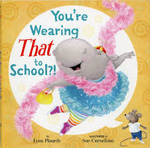 Penelope, a hippo, is excited about the first day of school while her best pal, Tiny, a mouse, keeps telling her that “school is tricky and you have a lot to learn.” He dissuades Penelope from wearing her rainbow sparkle outfit, packing a picnic for lunch, and bringing her favorite stuffed toy for show-and-tell and chooses for her instead a plain T-shirt, a rock for show-and-tell, and peanut butter and jelly for lunch, all of which are too ordinary in Penelope’s eyes. Thus, she ignores Tiny’s advice the next morning and appears at the bus stop as she originally plans, which surprises Tiny and makes him worry that his friend will have a lonely day. However, when the two join for lunch, Tiny finds that Penelope not only has a great day but also has made many friends who do the same thing as Penelope. This picturebook is a very good addition to the first-day-of-school books and reveals to children the importance of being true to oneself.
Penelope, a hippo, is excited about the first day of school while her best pal, Tiny, a mouse, keeps telling her that “school is tricky and you have a lot to learn.” He dissuades Penelope from wearing her rainbow sparkle outfit, packing a picnic for lunch, and bringing her favorite stuffed toy for show-and-tell and chooses for her instead a plain T-shirt, a rock for show-and-tell, and peanut butter and jelly for lunch, all of which are too ordinary in Penelope’s eyes. Thus, she ignores Tiny’s advice the next morning and appears at the bus stop as she originally plans, which surprises Tiny and makes him worry that his friend will have a lonely day. However, when the two join for lunch, Tiny finds that Penelope not only has a great day but also has made many friends who do the same thing as Penelope. This picturebook is a very good addition to the first-day-of-school books and reveals to children the importance of being true to oneself.
- Xiaoli Hong, The University of Georgia
Schmid, P. (2013). Oliver and his alligator. New York, NY: Hyperion Books.
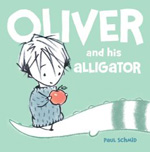 Starting the first day of school can be very frightening for young children, yet this picturebook can guide them to see how they can overcome the fear through imagination and creativity. In the picturebook, the character Oliver dreads the first day of school, so he stops by the swamp and picks up an alligator. At school, Oliver meets a lady, a girl, and many other children. However, Oliver is so nervous that he could only say two words “Munch, munch.” Thus, the alligator follows Oliver’s instructions and swallows everything that can be Oliver’s threats. Quickly, school becomes much quieter and of course a little lonely for him. Then Oliver hears singing and laughing from inside his alligator and he joins them by again saying the two words “Munch, munch.” The soft and spare crayon lines by Schmid provide appealing details but do not overwhelm the young readers.
Starting the first day of school can be very frightening for young children, yet this picturebook can guide them to see how they can overcome the fear through imagination and creativity. In the picturebook, the character Oliver dreads the first day of school, so he stops by the swamp and picks up an alligator. At school, Oliver meets a lady, a girl, and many other children. However, Oliver is so nervous that he could only say two words “Munch, munch.” Thus, the alligator follows Oliver’s instructions and swallows everything that can be Oliver’s threats. Quickly, school becomes much quieter and of course a little lonely for him. Then Oliver hears singing and laughing from inside his alligator and he joins them by again saying the two words “Munch, munch.” The soft and spare crayon lines by Schmid provide appealing details but do not overwhelm the young readers.
- Xiaoli Hong, The University of Georgia
GRADES 4-6
Chainani, S. (2013). The school for good and evil. New York: Harper.
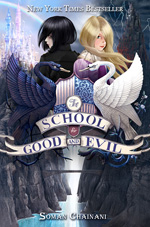 Once every four years, a mystical School Master comes to kidnap two children of Gavaldon. He takes them to the Schools for Good and Evil where they learn to act according to the roles rooted in fairy tale traditions. Finally, they graduate into fairy tales of their own. Beautiful Sophie dreams of getting into the School for Good and desperately wants to be kidnapped for her happily ever after life. However, her strange friend Agatha does not believe in fairy tales, and she doubts the possibility of a sincere transformation into fairy tale characters. When the two girls are kidnapped, Sophie ends up in the Towers of Evil, and Agatha goes to the School for Good. Both of them feel that they have been sent to the wrong places. Additionally, Sophie strives to prove that she belongs to the School for Good, but Agatha realizes that the best way out of this tricky situation is to get back home. Going through a number of dangerous adventures, misfortunes, and trials, the girls finally understand who they are as well as learn to be real friends. Based on the archetypical portrayal of traditional fairy tale characters, The School for Good and Evil represents an interesting twist that results in an intriguing role reversal, and the characters having to learn to adapt to different situations at their schools. The fast-paced plot gives a perfect opportunity to revisit folklore, traditional fairy tales, and archetypes in the classroom. Insightful, humorous, and adventurous, this story will garner gripping interest at the beginning of a school year and will help teachers to emphasize traditional values and morals. The School for Good and Evil is beautifully illustrated by the Italian illustrator and designer Iacopo Bruno and supported by an interactive website. These two components nicely enrich the storyline and might help to build intertextual connections for classroom discussions.
Once every four years, a mystical School Master comes to kidnap two children of Gavaldon. He takes them to the Schools for Good and Evil where they learn to act according to the roles rooted in fairy tale traditions. Finally, they graduate into fairy tales of their own. Beautiful Sophie dreams of getting into the School for Good and desperately wants to be kidnapped for her happily ever after life. However, her strange friend Agatha does not believe in fairy tales, and she doubts the possibility of a sincere transformation into fairy tale characters. When the two girls are kidnapped, Sophie ends up in the Towers of Evil, and Agatha goes to the School for Good. Both of them feel that they have been sent to the wrong places. Additionally, Sophie strives to prove that she belongs to the School for Good, but Agatha realizes that the best way out of this tricky situation is to get back home. Going through a number of dangerous adventures, misfortunes, and trials, the girls finally understand who they are as well as learn to be real friends. Based on the archetypical portrayal of traditional fairy tale characters, The School for Good and Evil represents an interesting twist that results in an intriguing role reversal, and the characters having to learn to adapt to different situations at their schools. The fast-paced plot gives a perfect opportunity to revisit folklore, traditional fairy tales, and archetypes in the classroom. Insightful, humorous, and adventurous, this story will garner gripping interest at the beginning of a school year and will help teachers to emphasize traditional values and morals. The School for Good and Evil is beautifully illustrated by the Italian illustrator and designer Iacopo Bruno and supported by an interactive website. These two components nicely enrich the storyline and might help to build intertextual connections for classroom discussions.
- Oksana Lushchevska, The University of Georgia
Goldblatt, M. (2013). Twerp. New York: Random House.
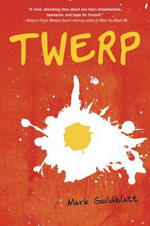 In his first book for young readers, Mark Goldblatt introduces us to Julian Twerski, or Twerp as his friends call him, who has done something really bad to his friend, Danley. The story is told from the perspective of Julian, who informs the reader that his English teacher, Mr. Selkirk, wants him to write so he can understand what happened to his friend. Julian begins to write about different adventures that he has in his town and decides that he would much rather continue writing and, heck, he would even write a whole book if he can get out of reading Julius Caesar. Julian says that Shakespeare drives him bananas. Mr. Selkirk agrees to this as long as Julian continues to write. Through his journal entries Julian describes his adventures as a twelve year old in love, through tough life decisions, his worries about being the fastest runner in school, and eventually describes what happed with Danley. Young readers can really connect with this book through Julian’s experiences told in a first personal narrative format.
In his first book for young readers, Mark Goldblatt introduces us to Julian Twerski, or Twerp as his friends call him, who has done something really bad to his friend, Danley. The story is told from the perspective of Julian, who informs the reader that his English teacher, Mr. Selkirk, wants him to write so he can understand what happened to his friend. Julian begins to write about different adventures that he has in his town and decides that he would much rather continue writing and, heck, he would even write a whole book if he can get out of reading Julius Caesar. Julian says that Shakespeare drives him bananas. Mr. Selkirk agrees to this as long as Julian continues to write. Through his journal entries Julian describes his adventures as a twelve year old in love, through tough life decisions, his worries about being the fastest runner in school, and eventually describes what happed with Danley. Young readers can really connect with this book through Julian’s experiences told in a first personal narrative format.
- Chelsey Bahlmann, The University of Georgia
Grabenstein, C. (2013). Escape from Mr. Lemoncello’s library. New York: Random House.
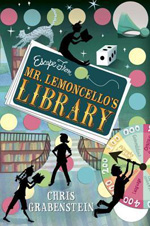 The town of Alexandriaville has been without a public library for twelve years. The previous library was torn down to build an elevated parking garage. A new state-of-the-art library was now being built and the details of the new library were being kept super-secret. Mr. Lemoncello, a master gamer in the town and the man behind the library, was holding an essay contest for the twelve year olds in town, who had lived their whole life without a public library. There would be twelve winners and those children would get the first library cards along with the privilege of staying the night in the library. What the winners don’t realize is that once they enter the library they must use clues from their library resources to find their way out. The children find the library is equipped with many futuristic features, including a holographic librarian. Who will find the clues to escape Mr. Lemoncello’s library and what will the prize be?
The town of Alexandriaville has been without a public library for twelve years. The previous library was torn down to build an elevated parking garage. A new state-of-the-art library was now being built and the details of the new library were being kept super-secret. Mr. Lemoncello, a master gamer in the town and the man behind the library, was holding an essay contest for the twelve year olds in town, who had lived their whole life without a public library. There would be twelve winners and those children would get the first library cards along with the privilege of staying the night in the library. What the winners don’t realize is that once they enter the library they must use clues from their library resources to find their way out. The children find the library is equipped with many futuristic features, including a holographic librarian. Who will find the clues to escape Mr. Lemoncello’s library and what will the prize be?
- Chelsey Bahlmann, The University of Georgia
Lagercrantz, R. (2013). My happy life. Reprint Edition. New Zealand: Gecko Press.
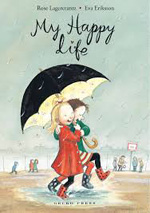 Dani has been waiting for the beginning of the school year at her new school all summer long. When the day comes, she is excited but scared as well. What if she cannot find any friends? Her father tries to calm Dani down and tells her to think about happy moments. As Dani makes friends with Ella, her life at the new school becomes full and complete. But, to Dani’s frustration, Ella and her family move out of town. Dani feels angry and lonely. She tries to find other friends among her classmates; however, Dani just seems to create drama. Following her father’s advice, Dani starts to write her own storybook about happy moments in her life. Then, she gets a letter from Ella that invites her to come to celebrate Easter with Ella’s family. This visit becomes a realization of what happiness really is; Dani sees happiness in simple things such as friendship, caring, and love. This book is about learning and navigating one’s life in a new school and living in a single-parent home. The illustrations of the book are done in ink, and since Eriksson mostly relies on lines, the images provide dynamics to the story. My Happy Life is translated from Swedish by Julia Marshal and will definitely serve the classroom as a good and vivid example of international children’s literature.
Dani has been waiting for the beginning of the school year at her new school all summer long. When the day comes, she is excited but scared as well. What if she cannot find any friends? Her father tries to calm Dani down and tells her to think about happy moments. As Dani makes friends with Ella, her life at the new school becomes full and complete. But, to Dani’s frustration, Ella and her family move out of town. Dani feels angry and lonely. She tries to find other friends among her classmates; however, Dani just seems to create drama. Following her father’s advice, Dani starts to write her own storybook about happy moments in her life. Then, she gets a letter from Ella that invites her to come to celebrate Easter with Ella’s family. This visit becomes a realization of what happiness really is; Dani sees happiness in simple things such as friendship, caring, and love. This book is about learning and navigating one’s life in a new school and living in a single-parent home. The illustrations of the book are done in ink, and since Eriksson mostly relies on lines, the images provide dynamics to the story. My Happy Life is translated from Swedish by Julia Marshal and will definitely serve the classroom as a good and vivid example of international children’s literature.
- Oksana Lushchevska, The University of Georgia
Meloy, M. (2013). The apprentices. Illus. by Ian Schoenherr. New York, NY: Putnam Juvenile.
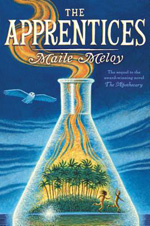 The Apprentices is a sequel to the critically acclaimed novel The Apothecary (2011) in which the characters Janie, Benjamin, and their friends successfully contained Soviet’s nuclear blast. Now two years after that, 16-year-old Janie has begun her new school life in New Hampshire and also her experiment of removing salt from water. Meanwhile her best friend Benjamin is treating the wounded in the jungles of Vietnam and keeps in touch with Janie through a mysterious powder he develops from the magic book, Pharmacopoeia. When Janie is held hostage by sinister forces due to the experiment she almost finishes, Benjamin and another friend of theirs, Pip, go across the continents to find her and they work again together to stop the new enemy’s scheme for nuclear weapons. Unlike the previous book, the narration is shifted among Janie, Benjamin, and Pip who live on different continents, yet the book continues to present the charm of magic and science abounding in the first book. The historical references to the Cold War and the tension in China and North Korea render the book more enjoyable alongside fantasy elements. The wonderful and graceful illustrations of Ian Schoenherr add a magical quality to the book.
The Apprentices is a sequel to the critically acclaimed novel The Apothecary (2011) in which the characters Janie, Benjamin, and their friends successfully contained Soviet’s nuclear blast. Now two years after that, 16-year-old Janie has begun her new school life in New Hampshire and also her experiment of removing salt from water. Meanwhile her best friend Benjamin is treating the wounded in the jungles of Vietnam and keeps in touch with Janie through a mysterious powder he develops from the magic book, Pharmacopoeia. When Janie is held hostage by sinister forces due to the experiment she almost finishes, Benjamin and another friend of theirs, Pip, go across the continents to find her and they work again together to stop the new enemy’s scheme for nuclear weapons. Unlike the previous book, the narration is shifted among Janie, Benjamin, and Pip who live on different continents, yet the book continues to present the charm of magic and science abounding in the first book. The historical references to the Cold War and the tension in China and North Korea render the book more enjoyable alongside fantasy elements. The wonderful and graceful illustrations of Ian Schoenherr add a magical quality to the book.
-Xiaoli Hong, The University of Georgia
Parnell, R. (2013). The mighty Quinn. Minneapolis: Scarletta Junior Readers.
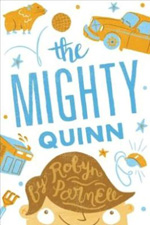 Quinn does not feel like he will ever be the star athlete or the son that will shine through the shadows of his younger sister, Mickey. It was two days before winter break and right before lunch, a new student appeared in Quinn’s fifth grade classroom. Neally is what she goes by, and she made an immediate connection with Quinn. Neally allows Quinn to see things in new perspectives. For example, on the weekends Neally’s family either picks up trash at the local park or goes to the local food bank to pack lunches, and her family rarely watches TV. This novel tackles important issues such as bullying, being the ESL student, caring for the environment, and tolerance that would offer a starting point for greater discussions in the classroom. The author provides discussion questions and ideas for extension activities to go along with the themes of this book.
Quinn does not feel like he will ever be the star athlete or the son that will shine through the shadows of his younger sister, Mickey. It was two days before winter break and right before lunch, a new student appeared in Quinn’s fifth grade classroom. Neally is what she goes by, and she made an immediate connection with Quinn. Neally allows Quinn to see things in new perspectives. For example, on the weekends Neally’s family either picks up trash at the local park or goes to the local food bank to pack lunches, and her family rarely watches TV. This novel tackles important issues such as bullying, being the ESL student, caring for the environment, and tolerance that would offer a starting point for greater discussions in the classroom. The author provides discussion questions and ideas for extension activities to go along with the themes of this book.
- Chelsey Bahlmann, The University of Georgia
GRADES 7-8
Auch, MJ. (2013). One + one=blue. New York: Henry Holt and Company.
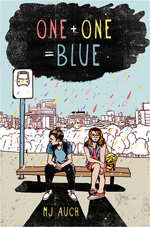 Basil, a self-proclaimed loser, lives with his grandmother because his mother left him when he was born to begin a career in in Hollywood. He was homeschooled until this year, in seventh grade. While at his new school he meets a new girl named Tenzie who seems to have similar quirks as him, such as their way of connecting numbers with colors. Tenzie doesn’t feel a close connection with her family because she is constantly at home alone. She develops a close relationship with Basil’s grandmother, which annoys the protagonist. One day Basil’s mother returns from Hollywood and Basil feels mixed emotions about her arrival. However, Tenzie looks up to Basil’s mother, but unfortunately she leaves town again without letting the family know. Tenzie convinces Basil to run away to find Basil’s mother and on this journey they learn a lot about themselves and each other. This book deals with issues familiar to middle graders such as fitting in, family structure, and friendships.
Basil, a self-proclaimed loser, lives with his grandmother because his mother left him when he was born to begin a career in in Hollywood. He was homeschooled until this year, in seventh grade. While at his new school he meets a new girl named Tenzie who seems to have similar quirks as him, such as their way of connecting numbers with colors. Tenzie doesn’t feel a close connection with her family because she is constantly at home alone. She develops a close relationship with Basil’s grandmother, which annoys the protagonist. One day Basil’s mother returns from Hollywood and Basil feels mixed emotions about her arrival. However, Tenzie looks up to Basil’s mother, but unfortunately she leaves town again without letting the family know. Tenzie convinces Basil to run away to find Basil’s mother and on this journey they learn a lot about themselves and each other. This book deals with issues familiar to middle graders such as fitting in, family structure, and friendships.
- Chelsey Bahlmann, The University of Georgia
Finneyfrock, K. (2013). The sweet revenge of Celia Door. New York, NY: Viking Juvenile.
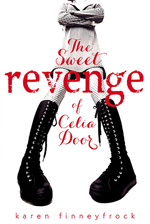 Ninth-grader Celia Door starts high school wanting revenge for what Sandy Firestone has done to her the previous year. Yet, she does not know how to get revenge, and Sandy and other girls’ increasing torment isolates her more as an outcast of her class. She can only seek refuge in writing poems in her notebook and pulling down hoodies. The arrival of Drake changes everything and brings sunshine into Celia’s life. He trusts her with his secret that he is gay and encourages her to pursue her dream of being a poet. Finally, when Celia finds a way to get back at Sandy, she decides that the joy of her friendship with Drake is sweeter than revenge. An amazing poet, Finneyfrock uses poems throughout the novel to illustrate Celia’s emotional state, which renders the novel very poetic. Touching upon issues common to teens such as absent parents, sexuality and bullying, it is a book young readers will easily identify with. Learn more about the author’s two books of poems at the author’s website.
Ninth-grader Celia Door starts high school wanting revenge for what Sandy Firestone has done to her the previous year. Yet, she does not know how to get revenge, and Sandy and other girls’ increasing torment isolates her more as an outcast of her class. She can only seek refuge in writing poems in her notebook and pulling down hoodies. The arrival of Drake changes everything and brings sunshine into Celia’s life. He trusts her with his secret that he is gay and encourages her to pursue her dream of being a poet. Finally, when Celia finds a way to get back at Sandy, she decides that the joy of her friendship with Drake is sweeter than revenge. An amazing poet, Finneyfrock uses poems throughout the novel to illustrate Celia’s emotional state, which renders the novel very poetic. Touching upon issues common to teens such as absent parents, sexuality and bullying, it is a book young readers will easily identify with. Learn more about the author’s two books of poems at the author’s website.
- Xiaoli Hong, The University of Georgia
Peters, K. V. (2013). William meets the Stick family. Toronto: Iguana Books.
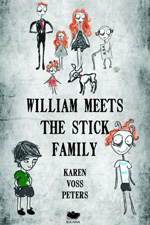 After a loss in his family, William Thrupp and his father move to a town called Brackenhill. William is expected to help his uncle in a law office and to attend a new school. Both things seem to be disasters, since life in the town seems very boring, and furthermore, William is not welcomed by his new classmates. The only person who welcomed William is a strange boy named Wrickety Stick. However, William starts to think differently when Wrickety helps him to retrieve a letter from the tiniest space. It turns out that Wrickety can shrink due to his extraordinary genetics, which are a family secret of the Stick family. As William and Wrickety become friends, they also have a number of adventures that are tied to the secrets of the Stick family. The book speaks to a number of themes such as school life, family relationships, and the possibility of finding friends in unexpected situations. William Meets the Stick Family is full of peculiarity and is also full of mysterious adventures.
After a loss in his family, William Thrupp and his father move to a town called Brackenhill. William is expected to help his uncle in a law office and to attend a new school. Both things seem to be disasters, since life in the town seems very boring, and furthermore, William is not welcomed by his new classmates. The only person who welcomed William is a strange boy named Wrickety Stick. However, William starts to think differently when Wrickety helps him to retrieve a letter from the tiniest space. It turns out that Wrickety can shrink due to his extraordinary genetics, which are a family secret of the Stick family. As William and Wrickety become friends, they also have a number of adventures that are tied to the secrets of the Stick family. The book speaks to a number of themes such as school life, family relationships, and the possibility of finding friends in unexpected situations. William Meets the Stick Family is full of peculiarity and is also full of mysterious adventures.
- Oksana Lushchevska, The University of Georgia
Weissman, E. B. (2013). The short seller. New York: Atheneum Books for Young Readers.
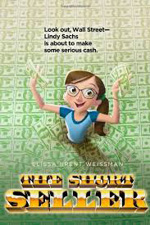 Seventh grader Lindy finds herself cooped up at home for a couple of weeks due to being sick with Mono. She mostly sleeps and soon is bored and ready to go back to school, but unfortunately because of her sickness she cannot. Her father asks her to do a favor for him one day while he is at work and shows her how she will put in his password and make some trades in the stock market. After she does this for him she becomes very interested and inquisitive about the stock market. Her father picks up on this interest and decides that he will give her one hundred dollars and she can trade it however she likes. She discovers that she is making money quickly and eventually gets a little too greedy with her parent’s money. This is a book teachers could use to introduce financial literacy and the potential risks and benefits of the stock market.
Seventh grader Lindy finds herself cooped up at home for a couple of weeks due to being sick with Mono. She mostly sleeps and soon is bored and ready to go back to school, but unfortunately because of her sickness she cannot. Her father asks her to do a favor for him one day while he is at work and shows her how she will put in his password and make some trades in the stock market. After she does this for him she becomes very interested and inquisitive about the stock market. Her father picks up on this interest and decides that he will give her one hundred dollars and she can trade it however she likes. She discovers that she is making money quickly and eventually gets a little too greedy with her parent’s money. This is a book teachers could use to introduce financial literacy and the potential risks and benefits of the stock market.
- Chelsey Bahlmann, The University of Georgia
GRADES 9-12
Charlton-Trujillo, E. E. (2013). Fat Angie. Somerville, MS: Candlewick Press.
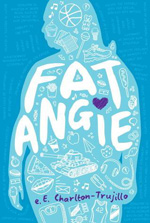 Fat Angie suffers from a posttraumatic stress disorder, since her sister disappeared in an attempt to save the world from terrorism and tyranny in Iraq. Fat Angie understands clearly that her sister wanted to be recognized by their mother, and Angie herself wants to become a person worthy of her mother’s time. Yet, Angie’s mother never pays attention to her. Despite Fat Angie’s attempts to be normal as her mother insists, she is a bully in her school. Everyone regards Angie as fat and unattractive, until KC Romance comes to the high school. KC finds that she has a lot in common with Angie, because similar to Angie, KC’s parents are divorced, and she feels strange and different from everyone else. When KC tells Fat Angie that she is a lesbian, Angie is frightened at the beginning, but soon understands her truest feelings towards KC. With encouragement and help, the two girls overcome a lot of problematic issues on their way to happiness and prove to everyone else that they can live their lives by following their own personal paths.
Fat Angie suffers from a posttraumatic stress disorder, since her sister disappeared in an attempt to save the world from terrorism and tyranny in Iraq. Fat Angie understands clearly that her sister wanted to be recognized by their mother, and Angie herself wants to become a person worthy of her mother’s time. Yet, Angie’s mother never pays attention to her. Despite Fat Angie’s attempts to be normal as her mother insists, she is a bully in her school. Everyone regards Angie as fat and unattractive, until KC Romance comes to the high school. KC finds that she has a lot in common with Angie, because similar to Angie, KC’s parents are divorced, and she feels strange and different from everyone else. When KC tells Fat Angie that she is a lesbian, Angie is frightened at the beginning, but soon understands her truest feelings towards KC. With encouragement and help, the two girls overcome a lot of problematic issues on their way to happiness and prove to everyone else that they can live their lives by following their own personal paths.
- Oksana Lushchevska, The University of Georgia
Daugherty, C.J. (2013). Night school. New York: Katherine Tegen Books.
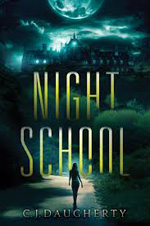 Allie continues to get in trouble at school and eventually ends up arrested. The school asks her parents to think of other schooling options, and her parents decide to send her to an elite boarding school. Her parents give hardly any details about this school, not even where it is located. Once they arrive at Allie’s new school, her parents are only allowed just inside the gates where they drop her off. She makes new friends easily, but many odd things begin to happen that freak her out. For one, she hears footsteps on the roof and possible screams outside. She also is given a large set of rules and is warned that the woods are dangerous to students after dark. She finds a love interest, but later on, after a fire during a school dance, she learns that there are many secrets that her closest friends, teachers, and even parents have been keeping from her. This book offers a suspenseful ending and entices readers to read the next book, Legacy.
Allie continues to get in trouble at school and eventually ends up arrested. The school asks her parents to think of other schooling options, and her parents decide to send her to an elite boarding school. Her parents give hardly any details about this school, not even where it is located. Once they arrive at Allie’s new school, her parents are only allowed just inside the gates where they drop her off. She makes new friends easily, but many odd things begin to happen that freak her out. For one, she hears footsteps on the roof and possible screams outside. She also is given a large set of rules and is warned that the woods are dangerous to students after dark. She finds a love interest, but later on, after a fire during a school dance, she learns that there are many secrets that her closest friends, teachers, and even parents have been keeping from her. This book offers a suspenseful ending and entices readers to read the next book, Legacy.
- Chelsey Bahlmann, The University of Georgia
Gardner, S. (2013). Maggot moon. Somerville, MS: Candlewick Press.
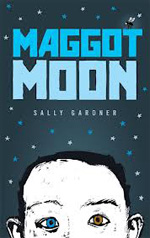 A winner of the Carnegie Medal and the 2013 Costa children’s book award, the novel Maggot Moon provides a glimpse into the life of a fifteen-year-old dyslexic boy, Standish Treadwell. Besides being a bully at school, his reality is full of conflicting issues. Living together with his grandfather in Zone Seven under the strict propagandistic regime of the Motherland, Standish dreams about a different, colorful life on the imaginary planet of Juniper. He created this planet together with his best friend Hector, who has recently been sent away from Zone Seven. To rescue Hector and his parents, Standish goes on a mission with the strongest belief in the future and an ambitious plan to change the Motherland. The fictional world of this book represents a dystopic England in the 1950s. However, this title can be discussed with an emphasis on any society with a violent and propagandistic ideology, for instance, the Soviet regime or competing ideologies of the USSR and the US during the Cold War period. Although the book is a dystopic novel, it traces a number of realistic reflections of the past as well as the attitude of a school teacher and students towards a dyslexic character. Read about the author and more about this title on the Maggot Moon website, which might provide educators with a marvelous opportunity to listen to some chapters in the book, watch a video, and then, introduce the Maggot Moon interactive iBook into the classroom.
A winner of the Carnegie Medal and the 2013 Costa children’s book award, the novel Maggot Moon provides a glimpse into the life of a fifteen-year-old dyslexic boy, Standish Treadwell. Besides being a bully at school, his reality is full of conflicting issues. Living together with his grandfather in Zone Seven under the strict propagandistic regime of the Motherland, Standish dreams about a different, colorful life on the imaginary planet of Juniper. He created this planet together with his best friend Hector, who has recently been sent away from Zone Seven. To rescue Hector and his parents, Standish goes on a mission with the strongest belief in the future and an ambitious plan to change the Motherland. The fictional world of this book represents a dystopic England in the 1950s. However, this title can be discussed with an emphasis on any society with a violent and propagandistic ideology, for instance, the Soviet regime or competing ideologies of the USSR and the US during the Cold War period. Although the book is a dystopic novel, it traces a number of realistic reflections of the past as well as the attitude of a school teacher and students towards a dyslexic character. Read about the author and more about this title on the Maggot Moon website, which might provide educators with a marvelous opportunity to listen to some chapters in the book, watch a video, and then, introduce the Maggot Moon interactive iBook into the classroom.
- Oksana Lushchevska, The University of Georgia
Roskos, E.(2013). Dr. Bird’s advice for sad poets. New York, NY: Houghton Mifflin.
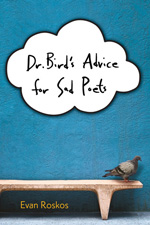 Roskos’s debut novel tells a story of a 16-year-old boy, James Whitman, who suffers from depression and anxiety. His bad mental conditions are caused by his abusive parents, a lack of friends and the recent expulsion of his sister from the house, who always stays as his companion before their bullying parents. While his parents refuse to take him to therapy, James battles with his mental conditions by reading Walt Whitman’s poetry, hugging trees on the way to school, and talking to an imaginary pigeon therapist, Dr. Bird. He works hard to hold back the dark feelings in his head and keeps himself upbeat and optimistic. After finding out the secret of his sister, which is very similar to his, he finally goes to a real therapist that he pays himself. The details of inner thoughts in James’s head enables readers to see the plight of teenagers troubled by depression and make us want to clap for the protagonist’s courage and self-esteem.
Roskos’s debut novel tells a story of a 16-year-old boy, James Whitman, who suffers from depression and anxiety. His bad mental conditions are caused by his abusive parents, a lack of friends and the recent expulsion of his sister from the house, who always stays as his companion before their bullying parents. While his parents refuse to take him to therapy, James battles with his mental conditions by reading Walt Whitman’s poetry, hugging trees on the way to school, and talking to an imaginary pigeon therapist, Dr. Bird. He works hard to hold back the dark feelings in his head and keeps himself upbeat and optimistic. After finding out the secret of his sister, which is very similar to his, he finally goes to a real therapist that he pays himself. The details of inner thoughts in James’s head enables readers to see the plight of teenagers troubled by depression and make us want to clap for the protagonist’s courage and self-esteem.
- Xiaoli Hong, The University of Georgia
Smith, A. (2013). Winger. Illus. by Sam Bosma. New York, NY: Simon & Schuster.
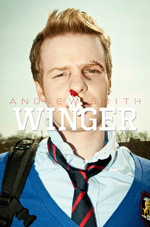 This coming-of-age novel describes the school life of 14-year-old junior Ryan Dean West, nicknamed Winger for his position on his boarding school’s rugby team at Pine Mountain. Ryan Dean must room with the rough seniors in Opportunity Hall, the dorm designed for trouble makers. Though he is a self-proclaimed loser, Ryan Dean is eager to prove his friendliness and skill to his rugby team and bravery to Annie, his crush. Life is accompanied by feelings of confusion, awkwardness, yet also joy for him until Joey, his best friend on the rugby team, is beaten to death. Somehow, he holds on to the important things, and he survives this horrendous event. This book is written by the author of The Marbury Lens (2000), who carefully weaves the feelings of hilarity and poignancy together in this book. Bosma’s comics inserted throughout the pages enable readers to be more perceptive of the character’s inner turmoil.
This coming-of-age novel describes the school life of 14-year-old junior Ryan Dean West, nicknamed Winger for his position on his boarding school’s rugby team at Pine Mountain. Ryan Dean must room with the rough seniors in Opportunity Hall, the dorm designed for trouble makers. Though he is a self-proclaimed loser, Ryan Dean is eager to prove his friendliness and skill to his rugby team and bravery to Annie, his crush. Life is accompanied by feelings of confusion, awkwardness, yet also joy for him until Joey, his best friend on the rugby team, is beaten to death. Somehow, he holds on to the important things, and he survives this horrendous event. This book is written by the author of The Marbury Lens (2000), who carefully weaves the feelings of hilarity and poignancy together in this book. Bosma’s comics inserted throughout the pages enable readers to be more perceptive of the character’s inner turmoil.
- Xiaoli Hong, The University of Georgia
These reviews are submitted by members of the International Reading Association's Children's Literature and Reading Special Interest Group (CL/R SIG) and are published weekly on Reading Today Online.